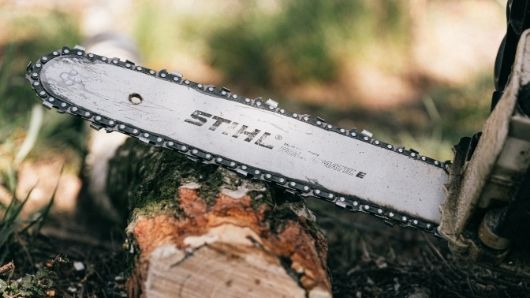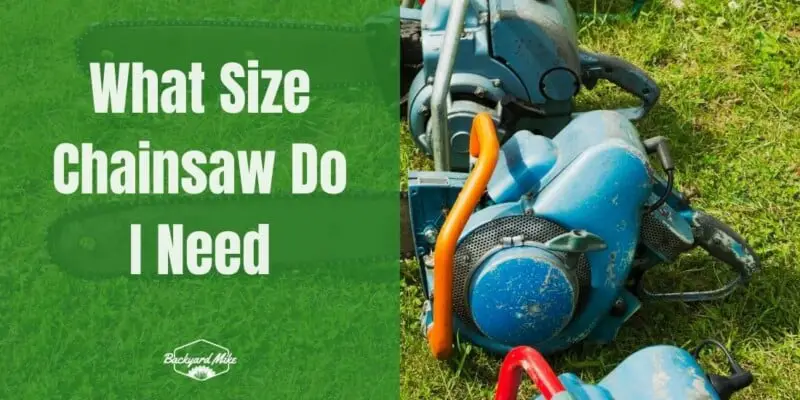Chainsaws come in all shapes and sizes.
With a lot of options, you might actually be wondering, “What size chainsaw do I need?” Well, there are many factors to consider, and it really depends on your needs.
Don’t worry though, in this guide, I’ll go through all the factors for you to be able to choose the PERFECT chainsaw size.
Now, let’s get to work.
Chainsaw Jobs
What kinds of tasks do you want to accomplish with your chainsaw? Do you want to prune limbs, or cut large trees?
I’m asking these questions because the type of task you want to do will affect the size of the chainsaw bars that you should buy.
Here are the chainsaw sizes you should get for the different kinds of jobs.
For Pruning Limbs
Pruning small limbs should be a simple enough task for a small-size chainsaw. For pruning, it’s actually better to use smaller, lighter chainsaws like electric chainsaws.
A smaller model of a chainsaw will help you control your cuts better. This will enable you to work longer EFFICIENTLY as well because the chainsaw is very lightweight.
As a rule of thumb, just pick a saw with a chainsaw blade with a length between around 6 – 10 inches.
For Removing Branches
When removing larger branches from trees, it’s best to go for a slightly bigger chainsaw size. Go for chainsaws with bar lengths ranging from 8 to 12 inches.
An electric chainsaw is still preferable and more common in the bar size range we’re looking for. So, if you prefer that type of saw, then good on you.
For Cutting Small Trees
For cutting small trees, you need a larger size chainsaw since you are dealing with a large diameter. For this type of activity, it’s best to go for a bar length of 12 – 14 inches.
For Cutting Firewood
Sure, you can cut firewood using an axe. It might take you a hundred years, though.
Using a chainsaw will definitely help you do the job FASTER so that you can get a hand on any other task you might have that doesn’t involve trees.
Chainsaws with a bar length of 16 – 20 inches would be the most IDEAL. [Check here the best 18-inches chainsaws]
A gas-powered chainsaw is common with that kind of bar length, so keep a lookout for any gas chainsaw in your area.
For Cutting Large Trees
“What size chainsaw do I need to cut big trees?”
Well, you should definitely buy a chainsaw with a cutting bar of at least 20 inches. You will find that a gas-powered chainsaw is common for a 20-inch bar.
These gas-powered chainsaws often have high engine displacement for heavy-duty use.
5 Factors You MUST Consider
Wood Diameter
The diameter of the wood you need to cut is also important when determining the chainsaw model that you need to purchase.
A good rule of thumb here is to add approximately 2 inches to the diameter measurement of the wood.
For instance, using a tape measure, you measured a diameter of 8 inches in the wood that you are about to work on.
In this case, you have to use a chainsaw that has a length of 10 inches.
Experience Level with Chainsaws
Your experience with using a chainsaw should be a big factor to consider when choosing sizes for pole saws and other chainsaws.
The size of your chainsaw does not only determine how much power it can deliver. Like turning a tree into a tree trunk, for example.
HEAVIER CHAINSAWS are also more likely to produce kickback. For inexperienced chainsaw owners, this can potentially be dangerous and even fatal.
Having more experience means you can minimize the kickback of the chain despite using a heavier chainsaw.
Chainsaw Control
It is also related to your ability to control your chainsaw. A longer length and bigger size also mean more weight.
The longer the guide bar length, the longer the chain. This bigger size would mean that your chainsaw would have to use a LARGER engine in order to make the saw run.
A chainsaw engine has a significantly LARGER weight as you get bigger in size. Making it way harder to control.
Imagine carrying around 50 pounds around your torso instead of 10. You’d get EXHAUSTED easily.
Physical Strength
Another factor, which is related to control is your physical strength. If you are fit and are capable of carrying heavy loads for a long time, then you can definitely use a larger size chainsaw.
Homeowners usually prefer an electric chainsaw because of this. Electric saw tools are often lighter, so you can work longer despite NOT being the strongest homeowner in the world.
Location
Where you need to cut is also an important factor. For home use, you should certainly buy smaller chainsaw sizes as this will still get the job done.
If you have trees on your property with large branches, consider buying a guide bar with a LONGER length, so you can still cut the branches of your trees.
Since the chainsaw is still for personal use, like for property maintenance, you should consider a balance of weight and power.
On the other hand, for an area prone to natural disasters, a storm cleanup might take place once or twice a year.
For these, you should have a little bit more power in the engine of your chainsaws to get the job done.
Don’t go too crazy on the guide bar size as you may have to be a little more mobile to get to all areas where trees are obstructing the way.
Frequency
For occasional light use, it’s best to use a chainsaw guide bar with a length of 14 inches or less. These are easier and cheaper to maintain than a larger chainsaw bar.
For frequent and heavy use, however, you should get a chainsaw guide bar with more power in the engine, ranging from 14 to 20 inches.
FAQ
What If I Need More Than One Size?
Ah, yes, the work you do needs different lengths of the chainsaw bar.
What do we do about this?
Well, if you have the budget, you can always buy different models of chainsaws to suit your needs.
Answer #1: Buy the Smaller Chainsaw
If money is an issue, you can always borrow from people at high-interest rates. JUST KIDDING! No, you shouldn’t do that.
If you really have to choose between different sizes, then you should pick the smaller size. You will be able to frequently use your smaller chainsaw compared to the larger models.
When the jobs require larger tools to pop up, you can just call people to step up to the challenge.
That way, you’ll be leaving the rare, difficult, and dangerous work to the professionals, while you saved yourself the time and money maintaining 2 different chainsaws.
Answer #2: Customize Your Chainsaw
Chainsaws can be customized. From the chain, the guide bar, to the sprocket, you can just mix and match.
The various parts (chain, guide bard, sprocket), have different sizes.
Check out the owner’s manual, go straight to the table of contents, and look for the measurement ranges the chainsaw can accommodate.
How Do You Measure a Chainsaw Bar?

The chainsaw guide bar is basically what determines the size of your chainsaw. It’s pretty important to get the measurement right.
You can get the length by using a tape measure and placing it on the base of the blade up until the blade tip. It’s as EASY as that.
Keep in mind that the bar lengths are often produced in EVEN numbers – 6, 8, 10 inches, and so on. You get it.
So don’t expect to see an 11-inch chainsaw guide bar anytime soon!
How Do I Maintain My Chainsaw?
Well, it really depends on how often you use your chainsaw.
If your overall working duration is longer, or you are faced with difficult operating conditions, like a dusty work area or resin-rich wood, then you should do maintenance work more often.
If you rarely use the chainsaw, then you could afford to do less maintenance work.
As a rule of thumb, you should check the following before every use:
- Chainsaw for leaks
- Trigger lock if working
- Chain break if working
- Chain if lubricated
- Saw chain if sharp and in tension
- Guide bar is still intact and sturdy
You should note that these are not the only things you can check on. Other people may be more stringent with the checklist, so feel free to ask experts about what other things you can look out for.
Conclusion
Congrats! You made it to the end. Hopefully, with this guide, you can finally answer the question, “What size chainsaw do I need?“
The short answer is, it really depends on what YOU need. That’s right.
So enjoy cutting, and remember to wear personal protective equipment and cut safely!


